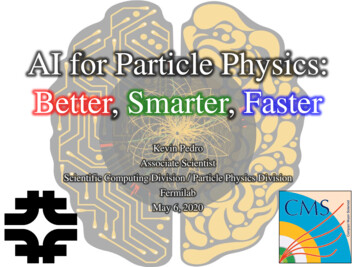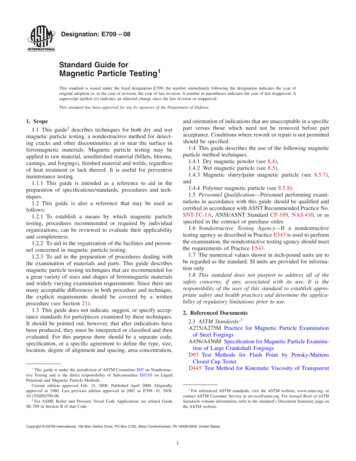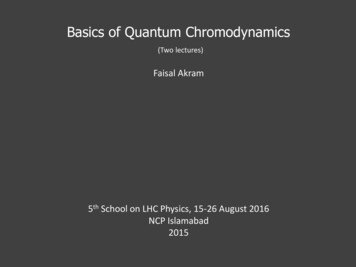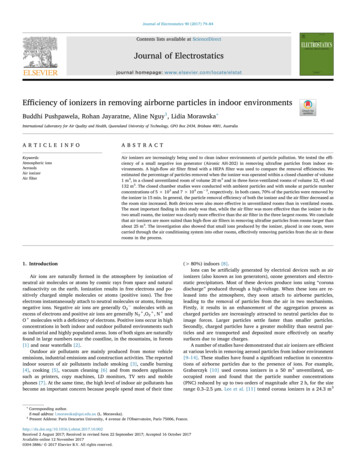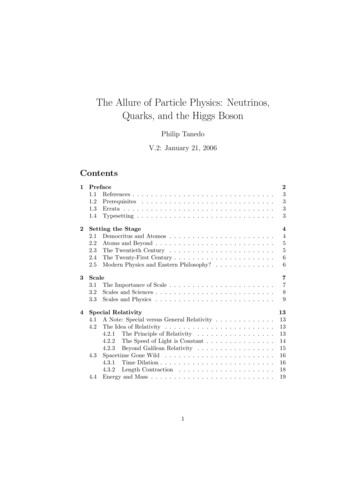
Transcription
The Allure of Particle Physics: Neutrinos,Quarks, and the Higgs BosonPhilip TanedoV.2: January 21, 2006Contents1 Preface1.1 References . .1.2 Prerequisites1.3 Errata . . . .1.4 Typesetting .233332 Setting the Stage2.1 Democritus and Atomos . . . . . . . . . .2.2 Atoms and Beyond . . . . . . . . . . . . .2.3 The Twentieth Century . . . . . . . . . .2.4 The Twenty-First Century . . . . . . . . .2.5 Modern Physics and Eastern Philosophy?.4455663 Scale3.1 The Importance of Scale . . . . . . . . . . . . . . . . . . . . . . .3.2 Scales and Sciences . . . . . . . . . . . . . . . . . . . . . . . . . .3.3 Scales and Physics . . . . . . . . . . . . . . . . . . . . . . . . . .7789.4 Special Relativity4.1 A Note: Special versus General Relativity4.2 The Idea of Relativity . . . . . . . . . . .4.2.1 The Principle of Relativity . . . .4.2.2 The Speed of Light is Constant . .4.2.3 Beyond Galilean Relativity . . . .4.3 Spacetime Gone Wild . . . . . . . . . . .4.3.1 Time Dilation . . . . . . . . . . . .4.3.2 Length Contraction . . . . . . . .4.4 Energy and Mass . . . . . . . . . . . . . .1.13131313141516161819
5 Quantum Mechanics5.1 If a tree falls and nobody is around.5.2 The Double Slit Experiment . . . . .5.3 Wave-Particle Duality . . . . . . . .5.4 Heisenberg Uncertainty Principle . .5.5 Quantum Field Theory I – Why does. . . . . . . . . . . . . . . . . . . . . . . . . . . . . . . . . . . . . . . . . . . . . . . . . . . . . . . . .every electron look alike?.2122232628306 Natural Units316.1 Length is Time . . . . . . . . . . . . . . . . . . . . . . . . . . . . 316.2 Energy is Time 1 . . . . . . . . . . . . . . . . . . . . . . . . . . . 326.3 Bonus: Mass is Energy . . . . . . . . . . . . . . . . . . . . . . . . 327 The Standard Model7.1 Quantum Field Theory II: virtual particles, antiparticles7.2 Fermions: Matter Particles . . . . . . . . . . . . . . . .7.2.1 Leptons . . . . . . . . . . . . . . . . . . . . . . .7.2.2 Quarks . . . . . . . . . . . . . . . . . . . . . . .7.3 Interactions . . . . . . . . . . . . . . . . . . . . . . . . .7.3.1 Charges . . . . . . . . . . . . . . . . . . . . . . .7.3.2 Conservation Laws . . . . . . . . . . . . . . . . .7.4 Bosons: Force Particles . . . . . . . . . . . . . . . . . .7.4.1 The photon and Quantum Electrodynamics . . .7.4.2 The W and Z Bosons and the Weak Force . . . .7.4.3 The Gluon(s) and the Strong Force . . . . . . . .7.4.4 The Higgs Boson and the Origin of Mass . . . .7.4.5 Where’s the Graviton? . . . . . . . . . . . . . . .7.5 Feynman Diagrams . . . . . . . . . . . . . . . . . . . . .7.5.1 The Idea . . . . . . . . . . . . . . . . . . . . . .7.5.2 The Feynman Rules of the Standard Model . . .33333333333333333333333333333333338 Beyond the Standard Model?348.1 Why we believe in physics beyond the Standard Model . . . . . . 348.2 Supersymmetry . . . . . . . . . . . . . . . . . . . . . . . . . . . . 348.3 Stringy-Wingy Theory . . . . . . . . . . . . . . . . . . . . . . . . 349 About the Author134PrefaceThese notes were prepared for a seminar on particle physics as part of SPLASH!,which is sponsored by Stanford University’s Educational Studies Program. Formore information regarding SPLASH!, see reference [1].2
1.1ReferencesOn the subject of references, I will try to include a lot of them! This is for tworeasons: (1) responsible academic writing requires careful citation of works togive credit where it is due, and (2) so that you, as students, can read furtherinto topics that interest you. This is important! The goal of this SPLASH!seminar is to get your feet wet and to introduce a new subject to you. It’s up toyou as the student to go nurture any interest in what is presented to you. Foryour convenience, references are included at the end of each section. Many ofthe references are books that you can find at public libraries or in a universityphysics library, such as Stanford’s (which is open to the public during regularhours).1.2PrerequisitesThis course was designed for intermediate high school students who have hadcourses in algebra and, ideally, some physics1 . The most important requirement,however, is an open mind and an interest in the subject. Don’t be afraid if alot of this is unfamiliar, if it gets you interested try to take in as much as youcan and then go to the references to dig deeper.1.3ErrataI have done my best to make sure that this document is free of errors. Whilesome level of metaphor (physicists call this “hand waving”) is required to bridgethe years between a first course in physics and a formal course in particle physics,it is my intent to keep this document scientifically honest and true to the spirit ofthe physics herein discussed. I will do my best to keep an updated version of thisdocument on my personal webspace to account for any errors or partial-errorsbrought to my attention post-printing [2].1.4TypesettingFor those who are considering a future in science or mathematics, this documentwas typeset using the LATEXtypesetting system. In physics and mathematicsnearly all professional papers are published using this system and students areexpected to ‘pick it up’ via osmosis of some sort. Tech savvy students might beinterested in getting a head start and familiarizing yourself with the system–Isuggest starting at the official LATEXproject webpage [3] and looking for a goodset of instructions for Windows installation [4].1 It is unfortunate that many schools have relegated physics to the end of the high schoolcurriculum. By the way, I’ll use footnotes for parenthetical statements that aren’t central tothe text.3
References[1] http://www.stanford.edu/group/esp/splash/.[2] http://www.stanford.edu/ flipt/, however this webspace will becomeobsolete in June 2006. Google or contact me directly to determine its URLafterwards.[3] http://www.latex-project.org.[4] http://www-cryst.bioc.cam.ac.uk/ paul/latex.html,2006.2January21,Setting the StageLet’s start with a definition.Physics. In current usage, restricted to The science, or group ofsciences, treating of the properties of matter and energy, or of theaction of the different forms of energy on matter in general (excluding Chemistry, which deals specifically with the different forms ofmatter, and Biology, which deals with vital energy)[1].Particle physics, in particular, is the study of the properties and actions ofthe elementary building blocks of matter. To motivate this field of science, weshould consider a brief and necessarily incomplete history of particles2 .2.1Democritus and AtomosDepending on who you ask, particle physics began with the ancient Greekphilosopher Democritus3 [2]. Democritus had the great idea that all matter–sand, water, people–was made up of identical, indivisible pieces that he calledatomos, meaning indivisible 4 . Why was this important? For the first time indocumented human history, somebody thought that all matter was made of thesame fundamental stuff–atomos. The atomos that made up water were the same2 I’m not sure, but I suspect that the phrase “a brief history of.” which has become verypopular in recent book titles originated with Stephen Hawking’s bestselling popular physicsbook, A Brief History of Time. This book is said to be one of the most purchased booksthat few people actually ever read I am guilty of this, and would suggest that young aspiringtheoretical physicists instead “read” the illustrated version. At any rate, Hawking’s titleis a play on words, but since there are far too many books titled “An Introduction To.,” Iimagine that authors began to use “A Brief History of.” instead, even without the Hawking’swordplay.3 These days physics and philosophy don’t always see eye to eye, but in ancient Greece,science and philosophy were one in the same, perhaps because they were both searching for‘truth’ in some sense. Ever wonder why scientists have Ph.D’s–doctorates in philosophy?4 For you SAT junkies, the roots of this word are a-, meaning not, and tomos, meaning cut.For example, PET (a way doctors image the brain) stands for Positron Emission Tomography–tomography means taking cross sections, or slices (cuts) to form a picture (graph) of an object.4
atomos that made up wine. The atomos that made up lead were the same as theatomos that made up gold. While this certainly has philosophical implications,physicists can look back and say that this helped nurture the development ofthe natural sciences because now all of nature was made up of the same atomos,which means that if we understood these atomos, then we’d understand natureat a fundamental level and we’d be able to reconstruct (hopefully) all of thecomplicated and varied behavior that we observe around us. (After all, howcould fire and water be made of the same atomos but behave so differently?)Now people had a reason to study particle physics. The first step (and perhapsthe most important) was figuring out what these elementary building blockswere.2.2Atoms and BeyondFast forwarding in scientific history [3], Western scholars developed a scheme forclassifying matter based on Mendeleev’s periodic table, in which a handful ofatoms constitute everything. But as science progressed, more and more atomswere discovered. Now we have over one hundred atoms on our periodic table.Hum! In hindsight5 , things were starting to look a little ugly. Democritus’idea of a single indivisible constituent material turned into a plethora of manyindivisible constituent materials! Why should there be so many? Perhaps eachof the atoms were made up of different configurations of even more fundamentalparticles?Around the turn of the century, an English physicist at Trinity College atthe University of Cambridge named Joseph John Thompson, discovered theelectron, a particle smaller than an atom that seemed to be an even morefundamental and that made up atoms. One of Thompson’s students, ErnestRutherford, later discovered that most of an atom’s mass was concentrated in anucleus which was composed of positively charged protons (Hydrogen nuclei)and, he hypothesized, neutral particles called neutrons. And so we have thepicture of three subatomic particles–the electron, proton, and neutron–whichcome together and form atoms, which, in turn, form molecules, which, in turn,form all the more complicated things in the universe. But are each of thosesubatomic particles fundamental, that is, indivisible in the sense of Democritus’atomos?2.3The Twentieth CenturyThe twentieth century was revolutionary for physics. On the one hand, itbrought forth Albert Einstein’s theory of relativity. On the other, it usheredthe era of quantum physics. I will introduce these topics below.After the Manhattan Project that developed the nuclear bomb, the UnitedStates government poured a lot of money into high energy physics. Thisis just another name for particle physics. To see why, consider the one thing5 And this is something we can only say in hindsight, since nature is the way it is. Sciencetries to understand it objectively, even if it doesn’t conform to what we originally expect.5
anybody knows about Einstein: E mc2 . This means energy, E, and mass, m,are equivalent up to a factor of the speed of light, c, squared. To study fundamental particles, physicists collide protons or electrons at high enegies, causingthem to produce new particles. In order to produce heavy, exotic particles, oneneeds to collide the protons or electrons at very high energies. Hence the name‘high energy physics.’ In the latter half of the twentieth century, national laboratories such as Fermilab and the Stanford Linear Accelerator Center pioneeredthe search for even more elementary particles. The particles and patterns ofinteractions they discovered have laid the groundwork for what is now calledthe Standard Model of particle physics.Quantum physics, further, has challenged our ideas of what ‘particles’ reallyare. This is something we’ll discuss later on. I will briefly talk about stringtheory and the physics of the twenty-first century towards the end of this document.2.4The Twenty-First CenturyBy the 1980s, particle physicists had developed a theory of elementary particles that was so successful and accurate in its predictions that they called itthe Standard Model of particle physics. The Standard Model accurately described the behavior of the weird quarks that made up protons and neutrons,the elusive neutrinos that pass through your body at a rate of about ten trillionper second, and the exotic composite particles discovered in accelerators. By theend of the century, nearly all of the particles that the theory predicted had beendiscovered exactly as the theory had predicted. The two notable exceptions arethe discovery that neutrinos have mass in the 1990s and the expected discovery of the Higgs boson at the Large Hadron Collider–the largest particlecollider to date (expected to turn on in 2007).2.5Modern Physics and Eastern Philosophy?I should note one more thing. I said above that Western scholars developed theframework for modern science. By and large this is true beginning, perhaps,around the Renaissance. However, this is not to say that Eastern thought hasnot contributed significantly to physics. In fact, many of the foundations ofmathematics were developed in the Middle East. In more recent times, manyhave tried to draw parallels between Eastern mysticism and modern physics.The quintessential book for this is the Tao of Physics [4]. However, books suchas this and more speculative works such as the recent movie What the Bleep DoWe Know tend not to be taken very seriously by most scientists and tend todiscuss qualitative and metaphorical connections rather than scientific fact.6
References[1] “physics, 2” The Oxford English Dictionary. 2nd ed. 1989. OED Online.Oxford University Press. 13 Jan. 2006 http://dictionary.oed.com/.[2] For a fantastic introduction to philosophy, I recommend Jostein Gaarder’sbook Sophie’s World. Democritus is described in the fifth chapter. For moreformal descriptions, I refer you to any beginning philosophy text.[3] And here I’m really skipping over some fascinating science and history thatI encourage you to look into. Your high school physics and chemistry booksmight be a good place to start. Just how did these clever scientists discoverthese things, anyway? In this section I paraphrase the relevant articlesfrom Wikipedia, http://en.wikipedia.org as of January 21, 2006. Pleasenote that this is not a rigorous nor comprehensive source, and I recommendindependent encyclopedic research on your own part if you intend to usethis information in your own scholarly work.[4] Capra, Fritjof. The Tao of Physics. Fritjof Capra also cowrote the screenplay for a film called Mindwalk, which I recommend to any young scholar.3ScaleIn the previous section, we discussed how physicists studying ‘fundamental’physics kept looking for ‘elementary’ particles: the “stuff” that ultimately makesup all other stuff. Implicit in this is the idea that ‘elementary’ particles aresmaller than the non-elementary stuff it makes up. This is just like saying thatindividual Lego blocks are smaller than the model of the Death Star that youmade out of them.3.1The Importance of ScaleScale turns out to be an incredibly important idea in physics for detailed reasonsthat are generally outside the scope of this seminar[1]. The gist of the idea,however, is that physics is different at different scales! That is to say that naturebehaves differently depending on how ‘big’ or how ‘small’ you’re examining it.This is both very surprising and very obvious. This is surprising because many ofus have been trained to read ‘facts’ out of textbooks and accept them as ‘truths’(this is not science, even though one might be learning about science6 ). Whyshould these ‘truths’ be any different depending on whether you’re looking at amicrometer or a kilometer? Who is to say what ‘big’ or ‘small’ is? (Certainlyatoms and galaxies would have different opinions on this, if they have opinionsat all.)6 Thedifference is the scientific method. I point this out only because recent events dealingwith science education have made it clear that a distressingly large number of Americancitizens do not have a clear understanding of what science is and why it is important.7
However, it is actually very obvious that physics should be different at different scales because we deal with situations every day where big things behavedifferently from small things. We know that giant ants from cheesy 1950s horror films cannot exist because their legs wouldn’t be able to support their bodyweight[2]. We know that little water beetles can float on a pond through surfacetension alone, but a battleship floats because of buoyancy (so they both float,but for very different reasons–i.e. because of different physics). More extremely,we know that atoms behave very differently from anything on a human scale(though curiously enough we believed for a long time that atoms looked verymuch like the solar system).The best example, perhaps, is Newton’s theory of gravity. Every high schoolphysics student knows how to calculate the gravitational pull of the moon bythe Earth. But every college physics student knows that Newton’s theory isonly an approximation to a more accurate theory, namely Einstein’s theoryof gravity (general relativity). Why, then, do we ‘waste time’ teaching highschool students theories that are ‘incorrect’ ? Because at the scales that highschool physics cares about (something between the scale of the solar system andsmall ball bearings) the predictions of Newton’s theory is pretty darn close tothose of the ‘correct’ theory. In fact, the difference is imperceptibly small. Fora student, however, the difference is significant: the Newtonian calculation ismuch easier and shorter than that the complicated general relativity calculation.The lesson of this, then, is that at different scales there are different effectivetheories, which we can think of as “really, really good approximations.” Ofcourse, if we were to do a calculation of the gravitational effects of a very massivegalaxy, Einstein’s approach is significantly more accurate than Newton’s–so theNewtonian approximation is not useful outside of its regime of effectiveness.It turns out that there’s a little more to this than just the fact that onetheory is a simpler “approximation” of another, and this leads to the idea ofeffective field theories, which we’ll discuss very briefly in the section on quantummechanics below.3.2Scales and SciencesWith all that in mind, I’d like to get the ball rolling with an overview of scalesand associated sciences to put particle physics in proper perspective. Todaymodern physics deals with nature both at the largest (cosmology) and smallest known scales (particle physics). The classic introduction to scale, which Irecommend highly, is Charles and Ray Eames’ famous short film, The Powersof Ten, where the Eames discuss objects from 1025 to 10 18 meters[3]. Muchof the material here, however, is motivated by lectures by Savas Dimopoulos7 ,who begins many his courses (even graduate courses) with a lecture on scale.In the following, everything is given to the nearest power of ten. When you’recomparing the size of a galaxy and the size of an ant, it’s ok if you’re off by a7 A professor theoretical physics at Stanford and the 2006 recipient of the American PhysicalSociety’s Sakurai Prize for lifelong contributions to theoretical physics.8
factor or two of ten8 .Length10 35 mScienceString Theory (?)10 15 mParticlePhysics,Nuclear Physics10 10 mAtomic and SolidState PhysicsChemistryMicrobiologyBiology10 8,9 m10 5 m1m3.3102,6 mEcology,ogy, etc.107 mEarth Science1012 mAstronomy, Astrophysics1018 m1026 mCosmologyCosmologyPsychol-ExamplesApprox. width of a hypotheticalstring. At distances smaller thanthis, the act of making a measurement might create a little black hole.Approx. scale of subatomic particles such as quarks. However, at thisscale, the ‘width’ of a particle is illdefined due to quantum uncertainty.This is about the width of a hydrogen or helium atom.The width of a molecule, like DNAThe width of a eukaryotic cell.The scale of everyday things, like agolden retriever.We have all sorts of “-ologies” at thisscale because this is the scale relevant to humans and groups of humans on an every day basis.The width of the Earth. (This isprobably a little larger than whatgeologists actually study.)The width of the solar system,though this is somewhat of an illdefined quantity depending on whatyou include in the solar system9 .The width of a globular cluster.The size of the observable universe.We don’t know if the universe is infinite beyond this.Scales and PhysicsMuch of science (and especially particle physics) has been driven by a paradigmof reductionism, the idea that in order to really understand something, one needsto understand its separate parts[5]. Implicit in this is the idea that there is somefundamental part that makes up everything, which is why many physicists aredrawn to the study of elementary particles.The lesson of all of this talk about scales can be summarized in the followingstatement:8 This is related to many jokes about cosmologists, who, if they can predict something towithin a factor of 100, are very excited that they’ve proved something.9
Figure 1: My own sketch of the scales of science.10
Figure 2: An example of insensitivity to different scales: a car driving on a long,straight road feels a smooth ride. The relevant scale is the width of the car’stire; so, for example, when the driver sees a rock that is about half the size ofhis tires on the road, he has to swerve to avoid it. At scales much smaller thanthis, say the scale of a pebble, the road is actually very bumpy (take a closelook at asphalt sometime). At scales much larger, such as the scale of a planet,the Earth itself is just one big bump. Despite these ‘bumps’ at different scales,the driver feels a smooth ride because he’s only sensitive to his own scale.A cook does not need to know string theory10 .This means that for the most part, you only care about what nature is doingat the scale you’re considering. A cook does not need to know how the atomsthat make up the molecules that make up the cells that make up the eggs that(s)he is cooking for breakfast–(s)he already has an understanding and a setof rules for how to make a meal (namely a recipe and whatever you learn atculinary school). The cook effectively has an understanding of what’s going on:when one puts eggs on a hot pan, they eventually coagulate into sunny side upeggs that one can eat. Of course, there’s a lot of good science in understandingwhat is actually going on there[6], but as far as what the cook needs to know,it doesn’t matter what’s going on at an atomic scale (it can be “magic” for allthe cook cares). Another example is seen in figure 2For physicists, this means that the results of particle physics 30, 60, 90 yearsago are (mostly) still valid today–even if we didn’t quite understand them correctly the first time around. In fact, we know that the Standard Model (whichwe’ll get to) is not a complete theory–for one, it does not explain gravity. Gravity, however, is an extremely weak force, which means–for reasons we won’t getinto–it becomes “relevant” (in some sense) at very small scales around 10 30 m.From the argument above, whatever the form of the quantum theory of gravitytakes (perhaps string theory), it won’t make the predictions of the StandardModel irrelevant.10 SavasDimopoulos11
In fancy language, this concept is referred to as an effective theory. Newton’s theory of gravity isn’t wrong just because Einstein’s theory of gravityappears to be correct. It’s just a theory that is effectively correct (very, very,very close to the result of Einstein’s theory) on the scale of everyday things(between about 10 2 m and 1010 m). In fact, we believe that even Einstein’stheory is only an effective theory of a more fundamental theory (perhaps stringtheory) that unifies gravity and the Standard Model.References[1] This is formally an idea called the renormalization group and is best described in the paper The renormalization group and the ² expansion byWilson and Kogut (Phys. Rep, 1974). This is, however, a graduate-leveltopic.[2] I wrote a short “just for fun” essay on this a few years ago, it is currentlyavailable at http://www.stanford.edu/ flipt/files/SoCo/them.pdf[3] The Films of Charles and Ray Eames – The Powers of 10 (Vol. 1), ImageEntertainment (1968). There is also a book by the same name.[4] In particular, this is motivated by his course Physics 351 given Autumn2005. Additional information came from a section from the website of JohnBaez (http://math.ucr.edu/home/baez/distances.html), a mathematical physicist at UC Riverside.[5] There are some eccentrics in physics who are challenging this idea of reductionism, the main stalwart being Nobel Prize winning physicist RobertLaughlin, who proposes a new paradigm in emergence–that many physicalphenomena are only explainable in terms of the joint behavior of a largenumber of parts that would otherwise be unexpected by studying only asingle part. That is, “the sum is greater than its parts.” Many of Laughlin’scomments haven’t been received particularly well by the particle physicscommunity (though is better received in the condensed matter physics community, in which his points of view are just facts of life). He has writtena popular-level book explaining his insights: A Different Universe, BasicBooks (2005). Check out the comments on Amazon.com for a sample of thedebate. Additionally, he prepared a more technical manifesto for the National Academy of Sciences (Proceedings of., 97, 28 (2000)), which is available at: m.[6] See,for ://www.bbc.co.uk/science/hottopics/cooking/, and a bookby Peter Barham, The Science of Cooking (Springer, 2001).12
4Special RelativityThe United Nations designated 2005 as the World Year of Physics in commemoration of Albert Einstein’s “Miraculous Year” in which he published groundbreaking papers on special relativity, Brownian Motion, and the photoelectriceffect. Over the course of his lifetime, he became an international pop iconknown for his famous equation, E mc2 . Here I’ll very briefly discuss the ideasof Special Relativity, but I’ll leave most of the details to your own reading.4.1A Note: Special versus General RelativityFirst a short note on nomenclature. Special relativity refers to Einstein’stheory of light objects that travel at very fast velocities. Special relativity isone of the standard pillars of modern physics that every undergraduate physicsstudent learns in college and, in it’s most minimal form, requires nothing morethan algebra to learn[1]. General relativity refers to Einstein’s theory of veryheavy objects and how they bend “the fabric of spacetime.” This was developedabout ten years after special relativity (and includes special relativity) and ismore mathematically involved[2]. It is usually a graduate-level subject that isclosely linked with a branch of mathematics called differential geometry. Herewe will talk about special relativity. Note that you’ll hear lots of people talkabout ‘grand unified theories’ that unite quantum mechanics and relativity.Statements like these refer to general relativity, as quantum mechanics andspecial relativity have already been successfully unified (this is called quantumfield theory).4.2The Idea of RelativityThere are two major pillars to the theory of special relativity. If you intend tounderstand anything about relativity, you have to understand these first.4.2.1The Principle of RelativityThe Principle of Relativity is, at the end of the day, an unremarkably obviousstatement.The Principle of Relativity. The laws of physics (nature) are thesame in every inertial frame of reference.What is this saying? An inertial frame of reference is one that is atconstant velocity. That is to say, you are in an inertial frame of reference (or“inertial frame” for short) if you can close your eyes and you can’t tell whetheror not you’re moving. In fact, this is exactly the statement of the Principle ofRelativity. Imagine you were in a closed box floating in space. In your inertialframe, you think that you and your box is stationary. However, suppose yourbest friend is also in a box floating in space, say at some fixed velocity. As hefloats by you, you think, “oh, poor bloke. he’s drifting away while I’m sitting13
here not moving.” Your friend, however, sees things slightly differently. Tohim/her, it is you that are drifting away while he/she is stationary.Who is ‘right?’ Both of course. This is because the laws of nature are thesame for each of you. Each of you can run little physics experiments in yourboxes and determine that the laws of physics are exactly the same as those inyour physics textbooks, so long as you remain in the inertial frame.What is not an inertial frame? One where the reference point is acceleratingrelative to another inertial frame. So a car that is speeding up is not an inertialframe. This is obvious–when we’re sitting in the car with our eyes closed, we feela backwards force when the car accelerates. The laws of physics are differentfrom when you’re just sitting in your living room.4.2.2The Speed of Light is ConstantThe second pillar of special relativity is the observation that the speed of lightis constant. This is something that has been confirmed experimentally, to
The Allure of Particle Physics: Neutrinos, Quarks, and the Higgs Boson Philip Tanedo V.2: January 21, 2006 Contents . 4For you SAT junkies, the roots of this word are a-, meaning not, and tomos, meaning cut. For example, PET (a way doctors image the brain) stands for Positron Emission Tomography


